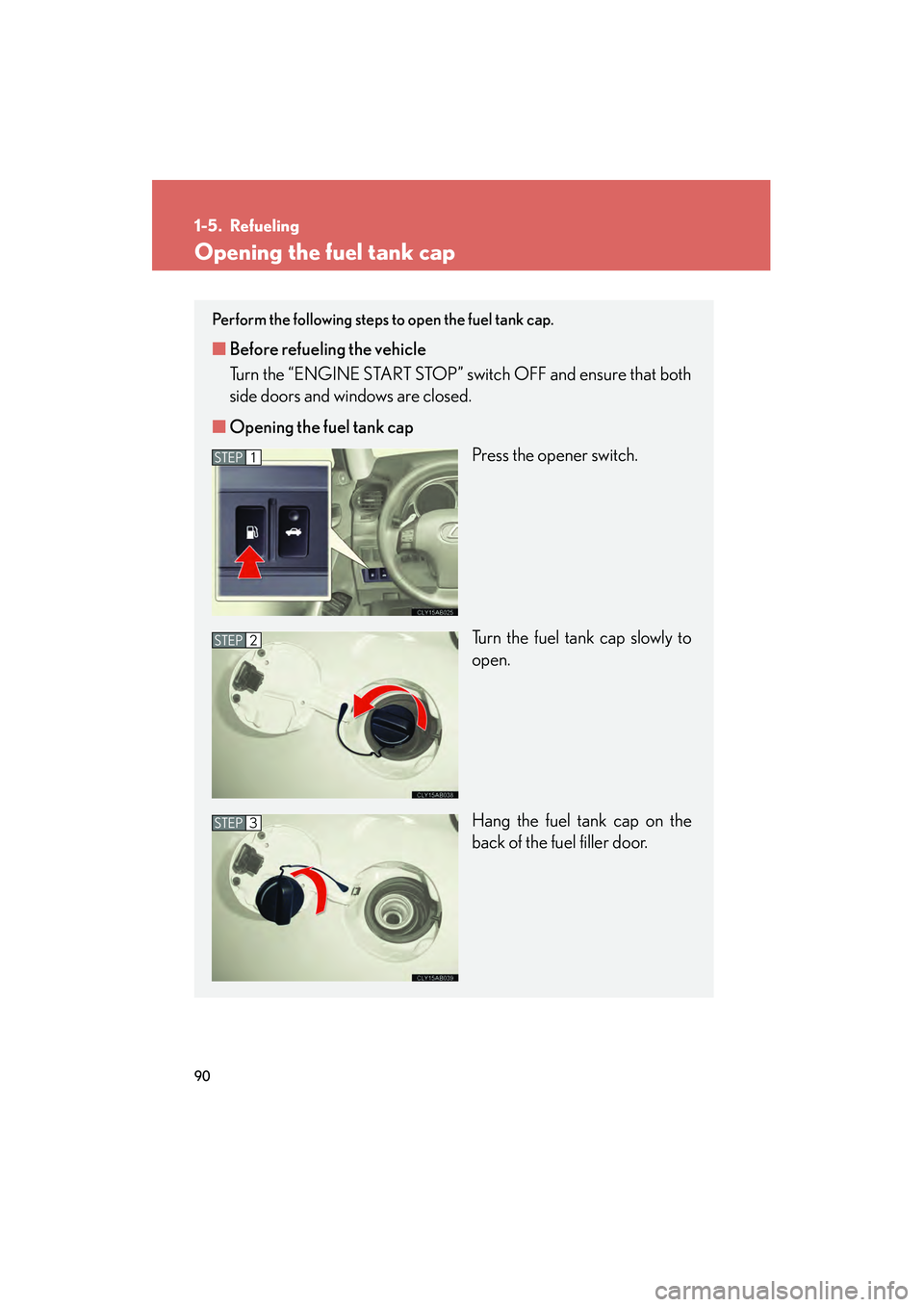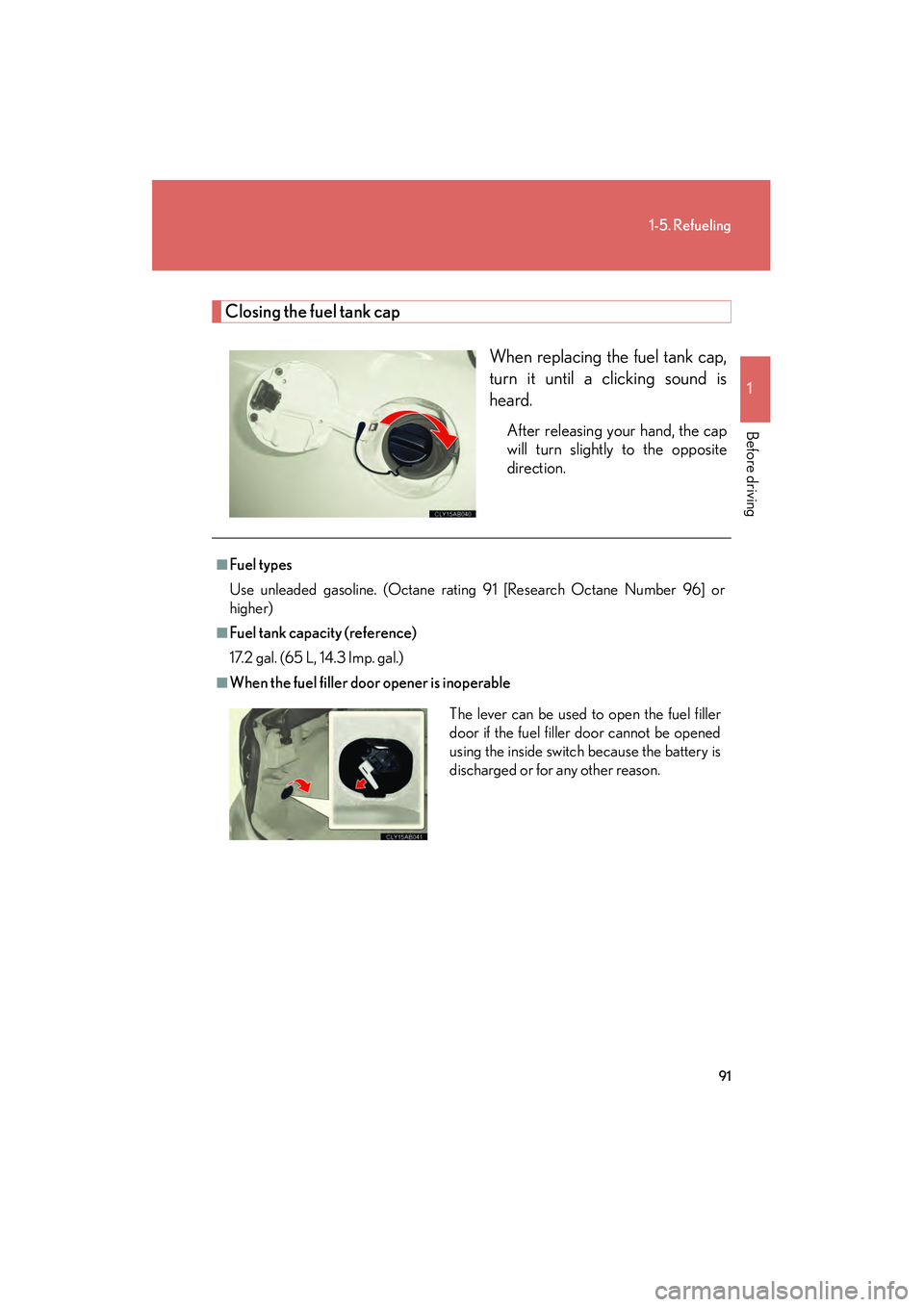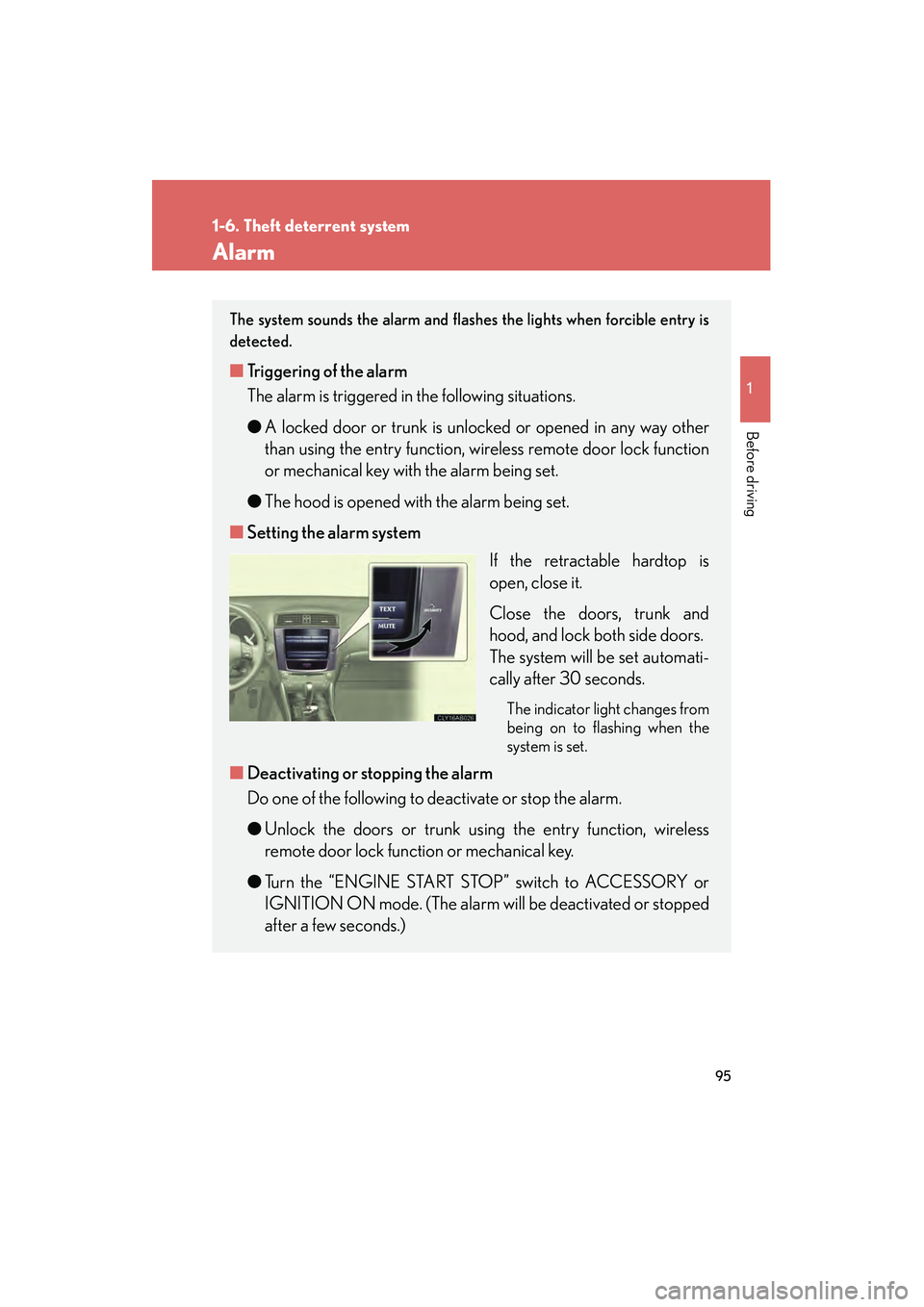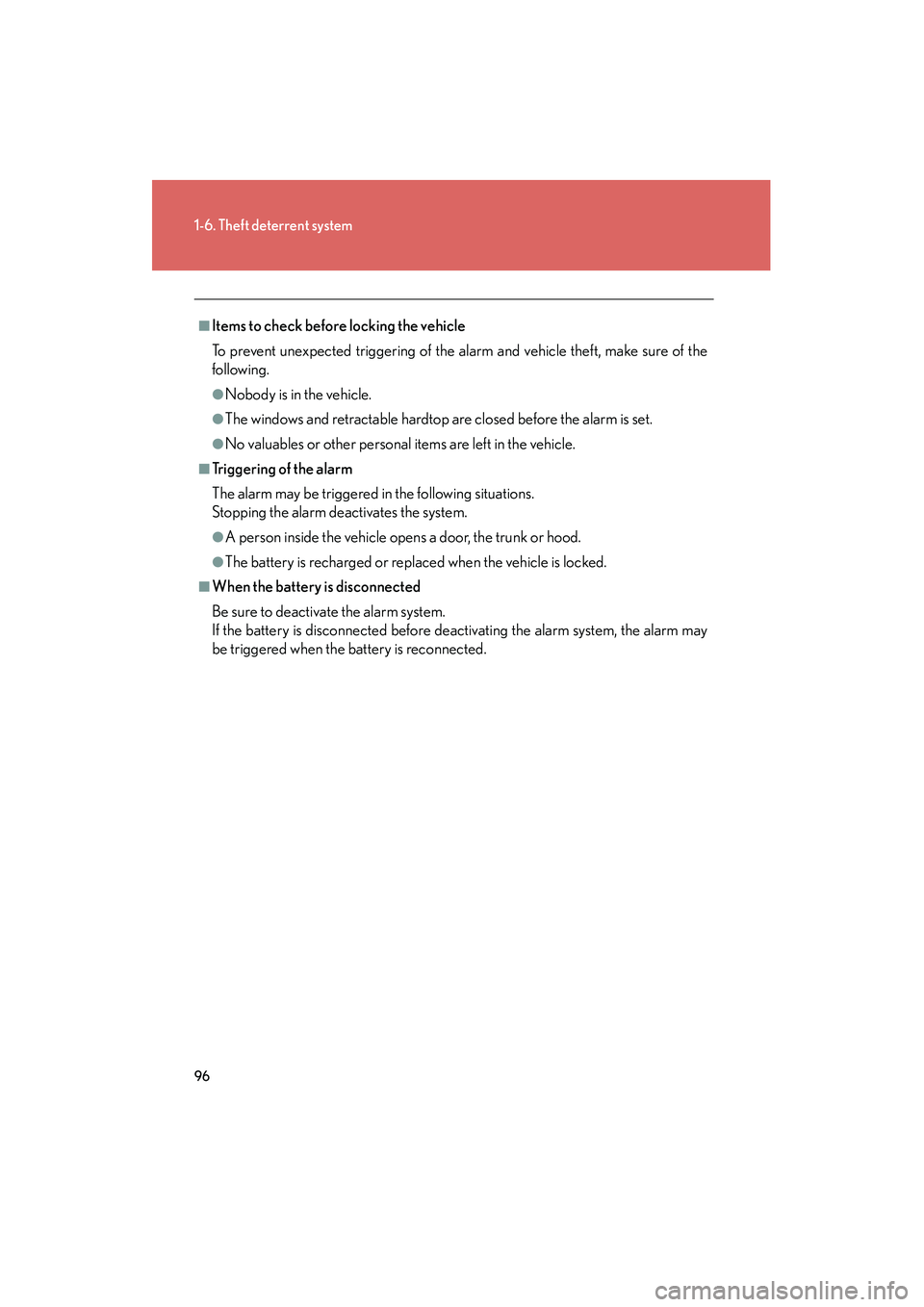Lexus IS250C 2010 Owners Manual
Manufacturer: LEXUS, Model Year: 2010, Model line: IS250C, Model: Lexus IS250C 2010Pages: 586, PDF Size: 31.62 MB
Page 91 of 586

90
10_IS250C/350C_U
1-5. Refueling
Opening the fuel tank cap
Perform the following steps to open the fuel tank cap.
â– Before refueling the vehicle
Turn the “ENGINE START STOP” switch OFF and ensure that both
side doors and windows are closed.
â– Opening the fuel tank cap
Press the opener switch.
Turn the fuel tank cap slowly to
open.
Hang the fuel tank cap on the
back of the fuel filler door.
STEP1
STEP2
STEP3
Page 92 of 586

91
1-5. Refueling
1
Before driving
10_IS250C/350C_U
Closing the fuel tank capWhen replacing the fuel tank cap,
turn it until a clicking sound is
heard.
After releasing your hand, the cap
will turn slightly to the opposite
direction.
â– Fuel types
Use unleaded gasoline. (Octane rating 91 [Research Octane Number 96] or
higher)
â– Fuel tank capacity (reference)
17.2 gal. (65 L, 14.3 Imp. gal.)
â– When the fuel filler door opener is inoperableThe lever can be used to open the fuel filler
door if the fuel filler door cannot be opened
using the inside switch because the battery is
discharged or for any other reason.
Page 93 of 586

92
1-5. Refueling
10_IS250C/350C_U
CAUTION
â– Refueling the vehicle
Observe the following precautions while refueling the vehicle. Failure to do so may
result in death or serious injury.
â—ŹTouch the vehicle or some other metal surface to discharge any static electricity.
Sparks resulting from discharging static electricity may cause the fuel vapors to
ignite.
â—ŹAlways hold the grips on the fuel tank cap and turn it slowly to remove it.
A whooshing sound may be heard when the fuel tank cap is loosened. Wait until
the sound cannot be heard before fully removing the cap. In hot weather, pressur-
ized fuel may spray out the filler neck and cause injury.
â—ŹDo not allow anyone that has not discharged static electricity from their bodies to
come close to an open fuel tank.
â—ŹDo not inhale vaporized fuel.
Fuel contains substances that are harmful if inhaled.
â—ŹDo not smoke while refueling the vehicle.
Doing so may cause the fuel to ignite and cause a fire.
â—ŹDo not return to the vehicle or touch any person or object that is statically
charged.
This may cause static electricity to build up, resulting in a possible ignition hazard.
â– When replacing the fuel cap
Do not use anything but a genuine Lexus fuel tank cap designed for your vehicle.
Failure to do so may cause a fire or other incident which may result in death or seri-
ous injury.
NOTICE
â– Refueling
Do not spill fuel during refueling.
Failing to do so may damage the vehicle, such as causing the exhaust systems to
operate abnormally or damaging fuel system components or the vehicle's painted
surface.
Page 94 of 586

93
1
Before driving
10_IS250C/350C_U
1-6. Theft deterrent system
Engine immobilizer system
â– System maintenance
The vehicle has a maintenance-free type of engine immobilizer system.
â– Conditions that may cause the system to malfunction
â—ŹIf the grip portion of the key is in contact with a metallic object
â—ŹIf the key is in close proximity to or touching a key to the security system (key
with a built-in transponder chip) of another vehicle
The vehicle's keys have built-in transponder chips that prevent the engine
from starting if the key has not been previously registered in the vehicle's
on-board computer.
Never leave the keys inside the vehicle when you leave the vehicle.
The indicator light flashes after
the “ENGINE START STOP”
switch has been turned OFF to
indicate that the system is oper-
ating.
Page 95 of 586

94
1-6. Theft deterrent system
10_IS250C/350C_U
â– Certifications for the engine immobilizer system For vehicles sold in the U.S.A.
FCC ID: NI4TMIMB-1
This device complies with Part 15 of the FCC Rules. Operation is subject to the fol-
lowing two conditions: (1) this device may not cause harmful interference, and (2)
this device must accept any interference received, including interference that may
cause undesired operation. For vehicles sold in Canada
Operation is subject to the following two conditions: (1) this device may not cause
interference, and (2) this device must accept any interference, including interfer-
ence that may cause undesired operation of the device.
L’utilisation de ce dispositif est autorisée seulement aux deux conditions suivantes:
(1) il ne doit pas produire de brouillage et (2) l’utilisateur du dispositif doit ĂŞtre prĂŞt Ă
accepter tout brouillage radioélectrique reçu, même si ce brouillage est suscepti-
ble de compromettre le fonctionnement du dispositif.
CAUTION
FCC WARNING:
Changes or modifications not expressly approved by the party responsible for com-
pliance could void the user’s authority to operate the equipment.
NOTICE
â– To prevent damage to the key
Do not modify, remove or disable the engine immobilizer system. If any unautho-
rized changes or modifications are made, the proper operation of the system can-
not be guaranteed.
Page 96 of 586

95
1
1-6. Theft deterrent system
Before driving
10_IS250C/350C_U
Alarm
The system sounds the alarm and flashes the lights when forcible entry is
detected.
â– Triggering of the alarm
The alarm is triggered in the following situations.
â—ŹA locked door or trunk is unlocked or opened in any way other
than using the entry function, wireless remote door lock function
or mechanical key with the alarm being set.
â—Ź The hood is opened with the alarm being set.
â– Setting the alarm system
If the retractable hardtop is
open, close it.
Close the doors, trunk and
hood, and lock both side doors.
The system will be set automati-
cally after 30 seconds.
The indicator light changes from
being on to flashing when the
system is set.
â– Deactivating or stopping the alarm
Do one of the following to deactivate or stop the alarm.
â—ŹUnlock the doors or trunk using the entry function, wireless
remote door lock functi on or mechanical key.
● Turn the “ENGINE START STOP” switch to ACCESSORY or
IGNITION ON mode. (The alarm will be deactivated or stopped
after a few seconds.)
Page 97 of 586

96
1-6. Theft deterrent system
10_IS250C/350C_U
â– Items to check before locking the vehicle
To prevent unexpected triggering of the alarm and vehicle theft, make sure of the
following.
â—ŹNobody is in the vehicle.
â—ŹThe windows and retractable hardtop are closed before the alarm is set.
â—ŹNo valuables or other personal items are left in the vehicle.
â– Triggering of the alarm
The alarm may be triggered in the following situations.
Stopping the alarm deactivates the system.
â—ŹA person inside the vehicle opens a door, the trunk or hood.
â—ŹThe battery is recharged or replaced when the vehicle is locked.
â– When the battery is disconnected
Be sure to deactivate the alarm system.
If the battery is disconnected before deactivating the alarm system, the alarm may
be triggered when the battery is reconnected.
Page 98 of 586

97
1
1-6. Theft deterrent system
Before driving
10_IS250C/350C_U
Theft prevention labels (U.S.A.)
These labels are attached to the
vehicle to reduce vehicle theft
by facilitating the tracing and
recovery of parts from stolen
vehicles. Do not remove under
penalty of law.
Page 99 of 586

98
10_IS250C/350C_U
1-7. Safety information
Correct driving posture
Drive in a good posture as follows:
Sit upright and well back in
the seat. (→P. 5 1 )
Adjust the position of the seat
forward or backward to
ensure the pedals can be
reached and easily
depressed to the extent
required. ( →P. 5 1 )
Adjust the seatback so that
the controls are easily opera-
ble.
Adjust the tilt and telescopic
positions of the steering
wheel downward so the air-
bag is facing your chest.
(→ P. 7 2 )
Lock the head restraint in
place with the center of the
head restraint closest to the
top of your ears. ( →P. 6 2 )
Wear the seat belt correctly.
(→ P. 6 5 )
Page 100 of 586

99
1-7. Safety information
1
Before driving
10_IS250C/350C_U
CAUTION
â– While driving
●Do not adjust the position of the driver’s seat while driving.
Doing so could cause the driver to lose control of the vehicle.
â—ŹDo not place a cushion between the driver or passenger and the seatback.
A cushion may prevent correct posture from being achieved, and reduce the
effectiveness of the seat belt and head restraint, increasing the risk of death or
serious injury to the driver or passenger.
â—ŹDo not place anything under the front seats.
Objects placed under the front seats may become jammed in the seat tracks and
stop the seat from locking in place. This may lead to an accident. The adjustment
mechanism may also be damaged.
â– Adjusting the seat position:
â—ŹTake care when adjusting the seat position to ensure that other passengers are
not injured by the moving seat.
â—ŹDo not put your hands under the seat or near the moving parts to avoid injury.
Fingers or hands may become jammed in the seat mechanism.